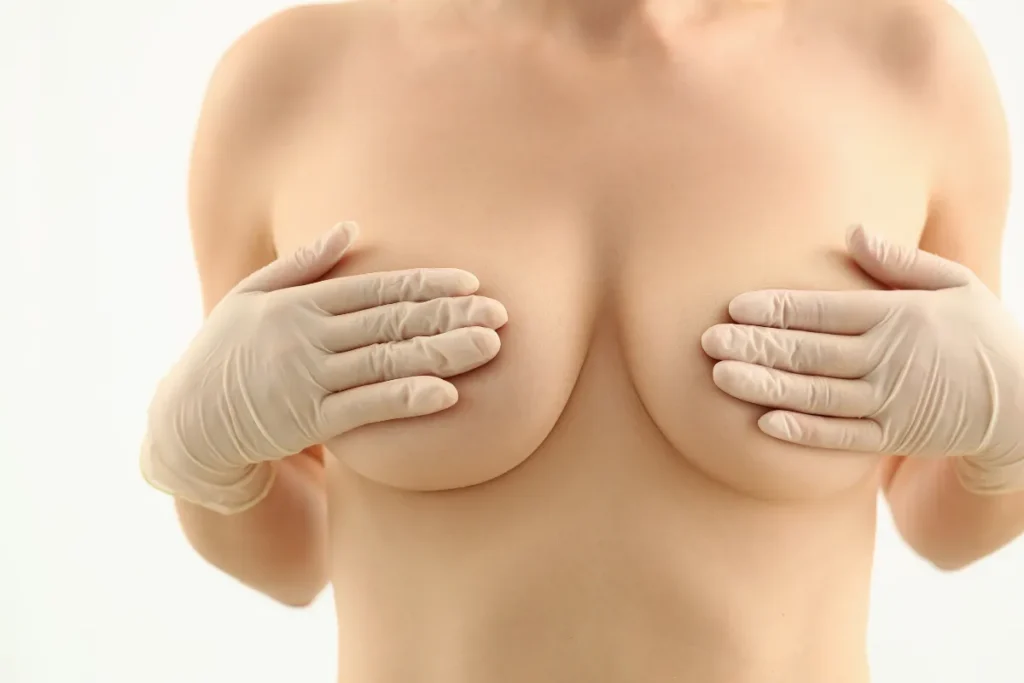How Is a Breast Lift (Mastopexy) Done? A Step-by-Step
By Partington Plastic Surgery on March 26, 2024 in Uncategorized

A popular surgery helping to contour and tighten breasts that may have dropped over time from pregnancy, weight loss, aging, or other causes is breast lift surgery, sometimes referred to as mastopexy. Safe and effective, it restores a youthful, elevated appearance and boosts confidence. This article explains “How is a boob lift done?” and guides you through each step.
Why Do People Consider a Breast Lift?
Many patients choose this surgical procedure to:
- Firm and perk breasts.
- Correct drooping brought on by pregnancy, nursing, weight changes, or aging.
- Adjust the nipples for balance and naturalness.
- They look refreshed enough for their own aesthetic tastes.
Breast Lift: Brief Overview
A breast lift, or mastopexy, improves breast look. A more youthful and elevated breast contour can be achieved by removing excess skin, tightening surrounding tissue, and repositioning the nipples. To improve shape and size, breast lifts are often combined with augmentation or reduction. These combined strategies let patients get more complete results catered to their particular aims and preferences.
Step 1: Preparation Before Surgery
Medical Evaluation and Health Assessment
Your medical history, pre-existing conditions, and medications and supplements are important because chronic diseases like diabetes, hypertension, and heart disease might slow recovery. The medical team will ask about any family history of breast cancer during the visit. Identifying inherited risks requires a complete family medical history. Blood tests and other diagnostic procedures can also be done to rule out any elements that might complicate the surgery and validate your general state of health.
Consultation and Personalized Planning
Preparation includes discussing cosmetic objectives and expectations with your surgeon. Your doctor will assess breast tissue elasticity and sagging. You will build your surgical plan that addresses your needs, including the procedure, recovery time, and expected results.
An excellent surgical experience relies on open communication with your surgeon. Asking questions builds confidence and clarifies the procedure, including how is a boob lift done, the possible risks, and the expected outcomes. No question is too small — your surgeon will guide you and provide the necessary details. By gaining this knowledge, you can feel confident and well-prepared for your surgery.
Lifestyle Adjustments
Some lifestyle changes are advised to maximize your outcomes and lower risk factors. Smoking slows healing and causes complications, so cease several weeks before and after the breast lift procedure. Achieving the greatest outcomes also depends on keeping a consistent weight since major weight changes might distort breast form. Your surgeon may recommend a balanced diet and exercise plan to improve your health before surgery.

Medication Guidelines
Review all drugs, vitamins, and herbal supplements you take with your surgeon. Some products may interfere with anesthesia or healing and must be discontinued. Some blood-thinning drugs and supplements, including aspirin or fish oil, for example, could raise bleeding risks after plastic surgery and must be stopped under your doctor’s instruction.
Arrange for Recovery Support
Breast lift surgery involves rest and care during early recovery, so planning is crucial. Set up someone to help you during the first days of recovery and drive you home following the surgery. A pleasant home recovery room with pillows, meds, and loose clothing can make healing easier and less stressful.
Preoperative Instructions
Your surgeon will provide specific preoperative instructions to ensure you understand how a boob lift is done and are fully prepared for the day of surgery. This may involve fasting, bathing, or skincare instructions, and wearing loose, easy-to-remove clothing to the procedure. Following these guidelines will maximize your safety and comfort before, during, and after the operation.
Careful preparation before breast lift surgery ensures a smooth procedure and better results. Every move is meant to give longevity, with your change as the top priority, along with safety and appropriate healing.
Step 2: Anesthesia
Anesthesia ensures comfort and painlessness during breast lift surgery. Two primarily utilized forms of anesthesia are:
- General Anesthesia: Puts you to sleep during the operation.
- Intravenous Sedation: Provides a milder degree of sedation, allowing you to remain calm but conscious throughout the operation.
Your surgeon will choose the best solution depending on your needs and medical history. Rest assured, comfort and safety come first always.
Step 3: Incision Techniques
It’s quite natural to wonder, “How is a boob lift done?” when we talk about incisions. The type of incisions, however, depends on your specific anatomy and goals:
- Peri-areolar incision: A circular cut made around the edge of the areola, the nipple. This is often used for modest to moderate drooping.
- Lollipop incision: Circles around the nipple then stretches vertically down to the breast crease. For some little sagging, this is perfect. This helps moderate sagging.
- Anchor incision: Includes the lollipops incision plus another cut down the breast crease. Usually reserved for severe sagging breasts or extra skin.
Your surgeon will walk you through the incision choices and advise the method best for you during your appointment.
Step 4: Reshaping and Lifting the Breasts
After making breast lift incisions, the surgeon will restructure the breast tissue to make it firmer and more attractive. The procedure involves:
- Restoring youthful breast tissue by lifting and contouring.
- Orienting the areola and nipple toward a higher, natural position. For balance and proportion, the areola may be decreased if big.
Here the goals are symmetry, proportion, and a natural look that accentuates your whole form.
Step 5: Removing Excess Skin
To reduce sagging and firmness, the surgeon removes superfluous skin after raising the tissue.

The degree of excess breast skin removal and the outcome of your treatment depends significantly on the flexibility of your skin. This step is essential for smoother, younger features.
Step 6: Closing the Incisions
The operation ends with incision closure. To firmly close the incision sites, your surgeon will apply surgical tape, skin adhesives, or sutures. To reduce scarring and speed healing, precise closure procedures are used. Although some scarring is unavoidable, most scars will dissolve somewhat rapidly with time. Your surgeon will also advise you on incision site care to promote healing and reduce scarring.
Step 7: Post-Surgical Dressing and Bandaging
Your breasts will be covered with gauze, bandages, or a support bra to help with swelling once the cuts close. Small drainage tubes may be needed to prevent fluid buildup.
Recovery and Aftercare
Though each person recovers differently, here is what to expect:
- In the first 1–2 weeks of healing, edema and minor discomfort are common. Your surgeon’s pain medications and care advice will help control these symptoms.
- Your surgeon will check your healing status at subsequent visits.
- Over 4–6 weeks, progressively increase activities. During this period, avoid hard lifting, intense exercise, and stomach sleeping. Under the direction of your surgeon, have a seamless recovery.
- Over the first year following the breast lift procedure, scarring will keep fading. Regular sunscreen and surgical site moisturization reduce scarring.
Your scars will eventually diminish and your outcomes will show more and more with time.
Risks and Complications
Knowing “How is a boob lift done?” and the possible risks and consequences is crucial for peace of mind. Breast surgery is generally safe, although risks and consequences should be considered. This includes:
- Infection: Though rare, infections can start within the surgery region or at the incision sites. Hygiene and surgical aftercare can reduce the risk.
- Bleeding: After surgery, some bleeding is normal, but major or prolonged bleeding may require medical treatment.
- Scarring: Although scarring is unavoidable, some patients develop bigger, elevated scars called hypertrophic or keloid scars.
- Changes in Sensation: Depending on the surgery extent, breast or nipple sensitivity may change temporarily or permanently.
- Capsular Contracture (for implant-based surgeries): Scar tissue develops firmly around the implant at this point, maybe causing distortion or pain.
- Anesthesia Risks: All procedures involve anesthetic risks, such as allergic responses or complications.
- Unsatisfactory Results: Although surgeons aim for the greatest outcomes, some patients could be unhappy with the cosmetic results or encounter asymmetry.
To understand how these risks pertain to you, discuss them with your surgeon during the consultation. They can help you create a strategy to reduce potential risks and maximize recuperation.
The Transformative Results of a Breast Lift
A breast lift can boost your confidence and bring your inner and outer selves into harmony. Restoring a more youthful, elevated look, this transforming surgery treats drooping or loss of shape resulting from aging, pregnancy, or weight changes. Although surgery might be scary, today’s advanced techniques and qualified specialists assure safe, effective results with minimal recovery time. This surgery enhances your general sense of self-esteem and well-being in addition to your appearance.
The question “How is a boob lift done?” has now become clearer, and you can consult a competent plastic surgeon to discuss your breast lift needs, goals, and expected results. Remember, you deserve an experience that gives your safety, comfort, and pleasure top priority; the decision to have surgery is personal.
Return to Overview